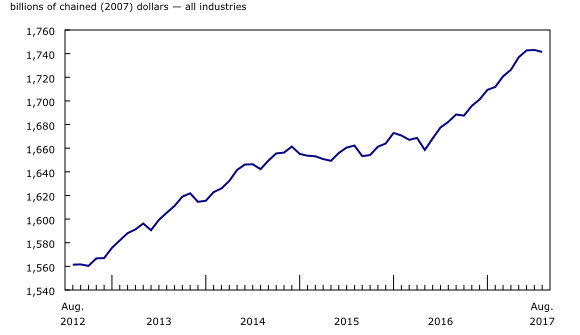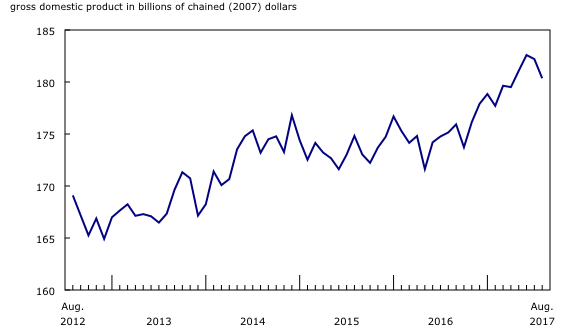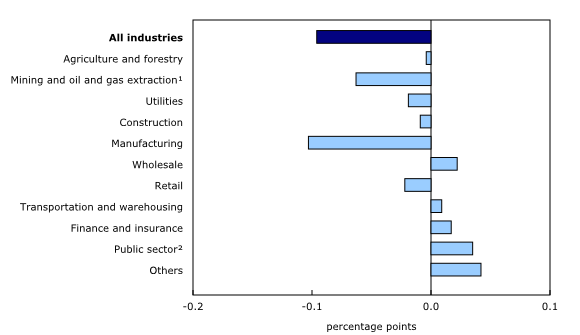Gross domestic product by industry, August 2017
Archived Content
Information identified as archived is provided for reference, research or recordkeeping purposes. It is not subject to the Government of Canada Web Standards and has not been altered or updated since it was archived. Please "contact us" to request a format other than those available.
Released: 2017-10-31
August 2017
-0.1% 
(monthly change)
Real gross domestic product (GDP) edged down 0.1% in August, after being essentially unchanged in July. Declines in manufacturing and mining, quarrying and oil and gas extraction more than offset increases in most sectors (12 out of 20).
Goods-producing industries contracted for the second consecutive month, declining 0.7% in August in part due to temporary reduced capacity in the manufacturing and the mining, quarrying and oil and gas extraction sectors. Services-producing industries edged up 0.1%.
The manufacturing sector declines
Following a 0.2% dip in July, the manufacturing sector contracted 1.0% in August as both durable and non-durable manufacturing declined.
Non-durable manufacturing decreased 2.0% following three consecutive months of growth as the majority of subsectors registered declines. Chemical manufacturing dropped 7.3%, its largest decline in the last 20 years, as all industry groups declined. Declines reflected in part some lost capacity due to plant maintenance shutdowns and lower demand from export markets for basic chemicals and pharmaceutical and medicinal products. There were notable decreases in manufacturing of petroleum and coal products (-3.1%) and plastic and rubber products (-2.5%). Food (+1.2%) and beverage and tobacco product manufacturing (+3.4%) were the only non-durable subsectors to increase.
Durable manufacturing declined 0.1% as 6 of 10 subsectors contracted. Fabricated metal (-3.2%) and miscellaneous manufacturing (-6.6%) contributed the most to the decline. Increases in machinery (+5.8%), primary metal (+1.4%) and electrical equipment (+1.9%) manufacturing partly offset the declines in other subsectors.
The mining, quarrying, and oil and gas extraction sector contracts
The mining, quarrying, and oil and gas extraction sector was down 0.8% in August, declining for the third consecutive month.
The oil and gas extraction subsector contracted 1.4%, with conventional oil and gas extraction declining 5.2% as both crude petroleum and natural gas extraction declined. Maintenance shutdowns in Newfoundland and Labrador in August affected conventional oil production. Non-conventional oil extraction grew 3.3%, more than offsetting a 3.0% decline in July.
Mining and quarrying (except oil and gas) expanded 2.5% in August. Non-metallic mineral mining grew 8.6%, led by a 14% increase in potash mining. Coal mining was up 6.2%. Metal ore mining declined 1.9% as growth in copper, nickel, lead and zinc (+4.4%) and gold and silver ore mining (+1.7%) was more than offset by declines in iron ore (-11%) and other metal ore mining (-3.4%).
Support activities for mining, oil and gas extraction declined 2.8%. This was a fourth consecutive decline after a string of increases that began in the summer of 2016.
Wholesale trade grows while retail trade declines
After growing 2.0% in July, wholesale trade gained 0.4% in August as five of nine subsectors grew. Leading the growth was a 4.4% increase in personal and household goods wholesaling, which rose for the sixth month a row. Miscellaneous (+1.5%), motor vehicle and parts (+1.3%) and petroleum products wholesaling (+2.3%) also increased. Building materials and supplies (-2.8%) and machinery, equipment and supplies wholesaling (-0.7%) gave back some of the gains registered in July.
The retail trade sector posted a 0.4% decrease as its 12 subsectors were evenly split between increases and decreases. The largest declines in terms of activity were at food and beverage stores (-2.0%) as most of the industry groups in the subsector registered decreases. There was less activity at store types traditionally associated with housing purchases and home renovation as both building material and garden equipment and supplies stores (-1.3%) and furniture and home furnishing stores (-2.3%) registered decreases. There were increases at clothing and clothing accessories stores (+1.3%), electronics and appliance stores (+2.0%) and motor vehicle and parts dealers (+0.4%).
Real estate rental and leasing edges up
Real estate and rental and leasing edged up 0.2% in August.
Following four consecutive months of decline, activity at the offices of real estate agents and brokers rose 0.3% in August, led by increases in the Greater Toronto and Greater Vancouver areas.
Finance and insurance edges up
The finance and insurance sector posted a gain of 0.2%, following a 0.6% decline in July, which was the largest in two years. Depository credit intermediation and monetary authorities grew 0.7% as activity at banking, monetary authorities and other depository credit intermediaries increased. Financial investment services, funds and other financial vehicles were down for a third consecutive month, declining 0.6%, while insurance carriers and related activities declined 0.2%.
Transportation and warehousing up slightly
Transportation and warehousing grew 0.2% as four of nine subsectors increased. Air transportation (+2.1%) rose for a third consecutive month as there was increased air traffic both from Canadian travellers and travellers to Canada from other countries. Postal service and couriers and messengers expanded 1.5% as both industries increased. Rail transportation contracted 1.8% as rail movement of automotive products, manufactured goods and intermodal freight declined. Pipeline transportation declined 0.6% as increases in pipeline transportation of natural gas (+0.7%) were more than offset by declines in crude oil and other pipeline transportation (-1.8%).
Construction edges down
The construction sector declined for a second consecutive month, edging down 0.1% in August. The declines in July and August have only given back part of June's 1.8% increase. Residential construction declined 0.9% from decreases in work put in place on single-family dwellings. Growth in non-residential (+0.5%) and repair construction (+0.7%) was more than offset by the declines in residential and engineering and other construction activities (-0.1%).
Other industries
The utilities sector was down 0.8% as electric power generation, transmission and distribution as well as natural gas distribution declined. Cooler than usual weather in August reduced electricity demand for air conditioning.
Professional services grew 0.3%, mainly attributable to increases in computer systems and related services (+0.5%) and management, scientific and technical consulting services (+0.9%).
Accommodation and food services edged up 0.1%, as a 1.0% rise in accommodation services was almost entirely offset by a 0.2% decline at food services and drinking places.
The public sector (education, health care and public administration) was up 0.2%, rising for the seventh month in a row.
Agriculture, forestry, fishing and hunting (-0.3%) was down.

In celebration of the country's 150th birthday, Statistics Canada is presenting snapshots from our rich statistical history.
At 4:11 p.m. Eastern time on Thursday, August 14, 2003, the lights went out unexpectedly in Ontario and the North-eastern United States, plunging some 50 million people and many businesses into darkness. It started when tree branches touched sagging transmission and distribution lines on a hot day in Ohio, knocking them out of commission. This caused a cascading overloading and failure of integrated electrical transmission and distribution systems around the Great Lakes and produced the largest power outage in the history of North America. The power outage prompted the declaration of a state of emergency in Ontario as disruptions were seen in the province and across the country. While most households had their electricity service resumed within a day, businesses and government offices across the province faced mandatory or voluntary power restrictions for a week, resulting in cutbacks and shutdowns.
In this context, real gross domestic product (GDP) contracted 1.0% in August 2003, the largest monthly decline in the last 35 years outside of the economic downturn at the end of 2008.
Wholesale trade was the sector that had the largest impact on the decline in GDP, dropping 6.7% as cross-border, interconnected supply and distribution channels were paralyzed. The manufacturing sector declined 2.0%, most notably in transportation equipment (-4.5%), chemical products (-3.6%) and fabricated metal manufacturing (-3.0%), all of which are heavy electricity users. Public administration contracted 3.1% as federal and Ontario provincial government workers lost work hours in the second half of August because of the outage and subsequent conservation period. In the transportation and warehousing sector, there were significant declines in urban transit systems and truck transportation. An estimated half-a-million urban transit users in Toronto experienced intermittent disruptions, and closures of the Ambassador Bridge, Walpole Island Bridge and Whirlpool Bridge border-crossings hampered movement of goods by truck and also congested traffic.
Sustainable Development Goals
On January 1, 2016, the world officially began implementation of the 2030 Agenda for Sustainable Development—the United Nations' transformative plan of action that addresses urgent global challenges over the next 15 years. The plan is based on 17 specific sustainable development goals.
The release on gross domestic product by industry is an example of how Statistics Canada supports the reporting on the Global Goals for Sustainable Development. This release will be used in helping to measure the following goal:

Note to readers
Monthly gross domestic product (GDP) by industry data at basic prices are chained volume estimates with 2007 as the reference year. This means that data for each industry and each aggregate are obtained from a chained volume index, multiplied by the industry's value added in 2007. Monthly data are benchmarked to annually chained Fisher volume indexes of GDP obtained from the constant-price supply and use tables (SUT) up to the latest SUT year (2013).
For the period starting with January 2014, data are derived by chaining a fixed-weight Laspeyres volume index to the prior period. The fixed weights are 2013 industry prices.
This approach makes the monthly GDP by industry data more comparable with expenditure-based GDP data, which are chained quarterly.
All data in this release are seasonally adjusted. For information on seasonal adjustment, see Seasonally adjusted data – Frequently asked questions.
For more information on GDP, see the video What is Gross Domestic Product (GDP)?
Revisions
With this release of monthly GDP by industry, revisions have been made back to January 2016.
Each month, newly available administrative and survey data from various industries in the economy are integrated and result in statistical revisions. Updated and revised administrative data (including taxation statistics), new information provided by respondents to industry surveys, and standard changes to seasonal adjustment calculations are incorporated with each release.
Real-time CANSIM tables
Real-time CANSIM table 379-8031 will be updated on November 20. For more information, consult the document Real-time CANSIM tables.
Next release
Data on GDP by industry for September will be released on December 1.
Products
For more information about monthly national GDP by industry, see the System of Macroeconomic Accounts module on our website.
The User Guide: Canadian System of Macroeconomic Accounts (13-606-G) is also available.
The Methodological Guide: Canadian System of Macroeconomic Accounts (13-607-X) is also available.
Contact information
For more information, contact us (toll-free 1-800-263-1136; 514-283-8300; STATCAN.infostats-infostats.STATCAN@canada.ca).
To enquire about the concepts, methods or data quality of this release, contact Allan Tomas (613-790-6570), Industry Accounts Division.
- Date modified:




